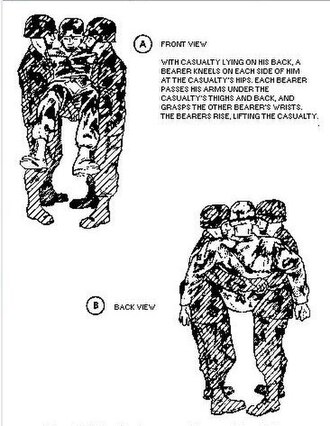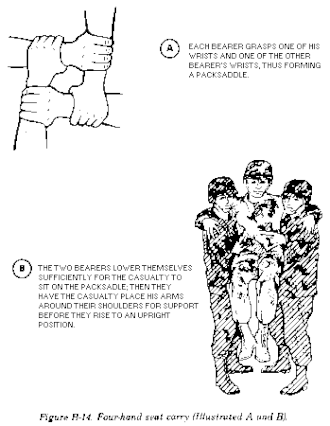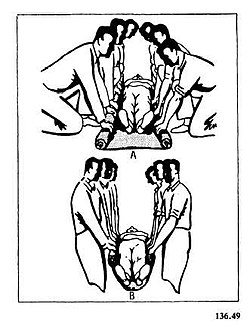Difference between revisions of "AY Honors/Basic Rescue/Answer Key"
m (Reverted edit of 81.109.197.2, changed back to last version by Jomegat) |
|||
| Line 8: | Line 8: | ||
{{:Adventist Youth Honors Answer Book/First aid/Electric_wire_contact}} | {{:Adventist Youth Honors Answer Book/First aid/Electric_wire_contact}} | ||
| − | + | ===b. A room filled with fumes or smoke=== | |
| − | + | {{:Adventist Youth Honors Answer Book/First aid/Smoke fire}} | |
| − | == | ||
| − | |||
| − | |||
| − | |||
===c. Clothes on fire=== | ===c. Clothes on fire=== | ||
Revision as of 19:35, 1 November 2007
1. What is the definition of an emergency rescue?
A rescue is the act of removing someone from danger. An Emergency Rescue is a technical term for a rescue taking place under hazardous circumstances and with high risk to the rescue personel, but must be done immediately to save a person's life. In this type of scenario to say a person is in immediate danger may be understated, normally if not removed from their circumstance as quickly as possible the victim will die quite soon. Technical rescues and rescue are descriptive of many types of circumstances, in all cases the victim is in danger. A cat up a tree or an otherwise uninjured person stuck in a crashed car are not likely to die in moments but will need to be rescued from their circumstance by someone with the means and skill to do so.
2. Show how to safely rescue a person from the following situations:
a. Being in contact with a live electric wire
Adventist Youth Honors Answer Book/First aid/Electric wire contact
b. A room filled with fumes or smoke
Adventist Youth Honors Answer Book/First aid/Smoke fire
c. Clothes on fire
Adventist Youth Honors Answer Book/First aid/Clothes on fire
d. Drowning using a non-swimming rescue
Adventist Youth Honors Answer Book/First aid/Non-swimming rescue
e. An ice accident
Adventist Youth Honors Answer Book/First aid/Ice rescue
3. Show three ways of attracting and communicating with rescue aircraft.
Adventist Youth Honors Answer Book/First aid/Signaling aircraft
4. Know six indications for the need of an immediate rescue.
- The victim has stopped breathing
- The victim has severe bleeding
- The victim is being electrically shocked
- The victim has a heart attack
- There is a fire
- The victim is drowning
- The victim has been poisoned
5. Know six procedures to follow before moving a victim from a life-threatening situation.
- The first task is to assess the whole situation and to plan the rescue.
- Be sure you can perform the rescue without injuring yourself.
- Make sure that moving the victim will not cause additional injury.
- Know where you intend to move the victim before lifting him.
- If bystanders must be used, it is essential that they be briefed in thorough detail on what you want them to do.
- Unless the danger is immediate, any first aid should be given before moving the victim.
- If you suspect a spinal injury, do not move the victim.
6. Know five principles involved in moving a victim from a life-threatening situation
- Be sure that it is necessary to move the victim. If it is not, do not move the victim.
- Know how you will move the victim before trying to move him.
- Know where you will move the victim before trying to move him.
- Be sure that you are able to lift the victim before lifting him. If the victim is too heavy, drag him instead.
- Maintain your balance. Do not start the move from an unbalanced position.
- Keep your footing throughout the move.
7. Know the proper ways to help a victim, without assistance, in the following:
a. Pulling the victim
Adventist Youth Honors Answer Book/First aid/Shoulder drag
Adventist Youth Honors Answer Book/First aid/Blanket drag
b. Lifting the victim
Adventist Youth Honors Answer Book/First aid/Firemans carry
Adventist Youth Honors Answer Book/First aid/Pack strap carry
c. Assisting a victim in walking
Adventist Youth Honors Answer Book/First aid/Support carry
8. Know the proper way to help a victim, with assistance, in the following:
a. Chair carry
Two rescuers can also remove a victim by seating him or her on a chair:
- Rescuer 1: Facing the back of the chair, grasp the back uprights.
- Rescuer 2: Facing away from the victim, reach back and grasp the two front legs of the chair.
- Both rescuers: Tilt the chair back, lift, and walk out.
b. Fore-and-aft carry

c. Two-handed and four-handed seats
The two-hand seat carry is used in carrying a casualty for a short distance and in placing him on a litter.
Only a conscious casualty can be transported with the four-hand seat carry because he must help support himself by placing his arms around the bearers' shoulders. This carry is especially useful in transporting the casualty with a head or foot injury and is used when the distance to be traveled is moderate. It is also useful for placing a casualty on a litter.
d. Blanket carry
The casualty is placed in the middle of the blanket lying on his back. Three or four people kneel on each side and roll the edges of the blanket toward the casualty, as shown in part A of the figure. When the rolled edges are tight and large enough to grasp securely, the casualty should be lifted and carried as shown in part B of the figure.
e. Three-man hammock carry with victim in supine and prone position
f. Three- or four-man lift
g. Six-man lift and carry
9. Know how to properly use a stretcher and carry a victim on a stretcher. Know how to make an improvised litter.
Adventist Youth Honors Answer Book/First aid/Litter carry
Adventist Youth Honors Answer Book/First aid/Improvised litter
10. Know how to properly use ropes and knots as follows:
a. Tie knots for joining ropes together
Adventist Youth Honors Answer Book/Knot/Sheetbend
Adventist Youth Honors Answer Book/Knot/Square
Adventist Youth Honors Answer Book/Knot/Surgeons
b. Tie knots for shortening a rope
Adventist Youth Honors Answer Book/Knot/Sheepshank
c. Tie knots for use around a person for a rescue
Adventist Youth Honors Answer Book/Knot/Bowline
d. Coil and accurately throw a light and a heavy 50-foot (15.2 m) rope.
Seperate the rope into two equal sized coils, with a little less than half the rope in each coil. Choose one end that you will hang on to, and grasp it firmly in the palm of one hand, using the three smallest fingers to hold it securely. Hold the rest of that coil between the index finger and thumb, and hold the other coil in the other hand. Take aim, and throw both coils toward the victim at the same time while retaining your grip on the end. If you have difficulty with this, try standing on the end of the rope you wish to keep with you. Using this method, you can throw the rope quite a bit farther than if you had thrown a single coil. This is because the second coil will not begin to unravel until the first one uncoils. Practice until you can hit a target with the rope from the 50-foot (15 meter) mark.
11. What steps should be taken before reporting a lost person? What information will be needed when reporting a lost person? How is a search for a lost person conducted in a wilderness area?
Before reporting:
- Children
If at home check your home carefully, contact your child's friends and your neighbors quickly to see if your child is with one of them. If at a store or mall contact management or security and have the child paged, if needed many stores today will "lock down" until all people and places are checked. If in a public place, do not panic. Try a high spot such as a chair or table to get a better vantage, and contact the facility management if there is one.
Gather yourself and be prepared to provide information to the police that will be relevant to the search for your child.
- Adult
Adults must be missing for 24 hours and in some places 48 hours before a report can be filed. Contact known friends, work, and hang outs before reporting an adult missing. Adults who are mentally unstable for any reason or in need of medication for survival can normally be reported immediately as missing.
- Those on outings
If you are expecting loved ones to return from an outing and they are overdue be sure to contact their various phones and their home before calling authorities. If this is travel, some delays may be caused by weather and other circumstances that can be checked by calling the airport or travel authority for their means of travel. Road conditions can normally be checked through the state's department of transportation or the department of public safety (Highway Patrol). For those who were camping, hiking, or the like you will contact the forest/park authority for weather and road issues.
Be sure to have information on planned hiking routes and camping locations left behind by your loved ones so they can be used in a search if needed.
- What will be needed
The more detailed your physical description to police can be the better. The color of eyes, hair and skin are needed but are not truly distictive. Pictures are best and any identifying marks such as scars will help to identify a particular person quite well. The clothes the missing or lost person was wearing when last seen are very helpful too, as well as details on the vehicle(s) any adults may have been driving when last seen.
Age, date of birth, and other personal details such as family nicknames and family known information are helpful in child abduction cases. This information can not only be used to identify a child but to retrieve the child and gain trust with police. The person's doctor and dentist will also be helpful so have those names ready if possible.
- Searches
Adventist Youth Honors Answer Book/First Aid/Searches




